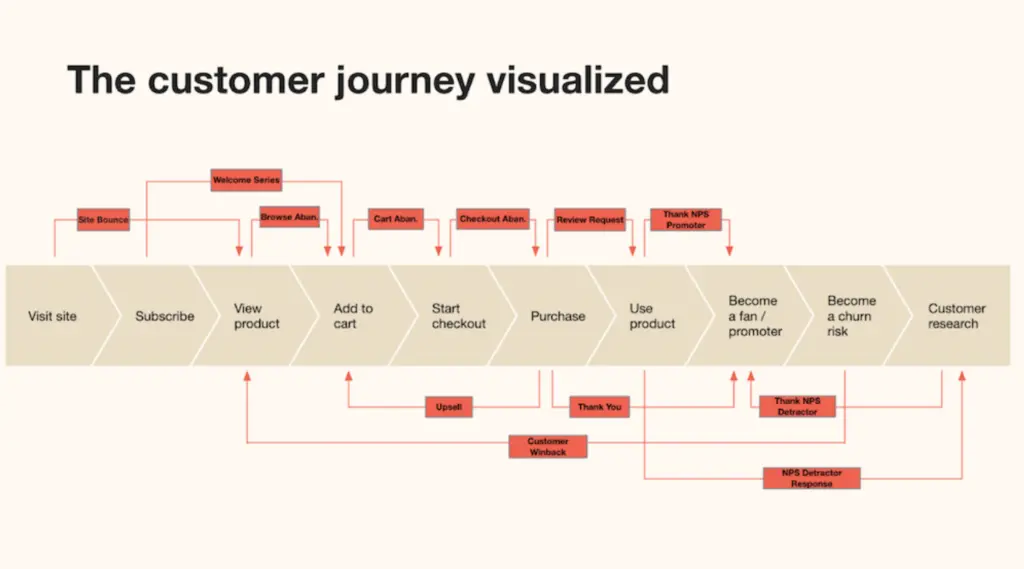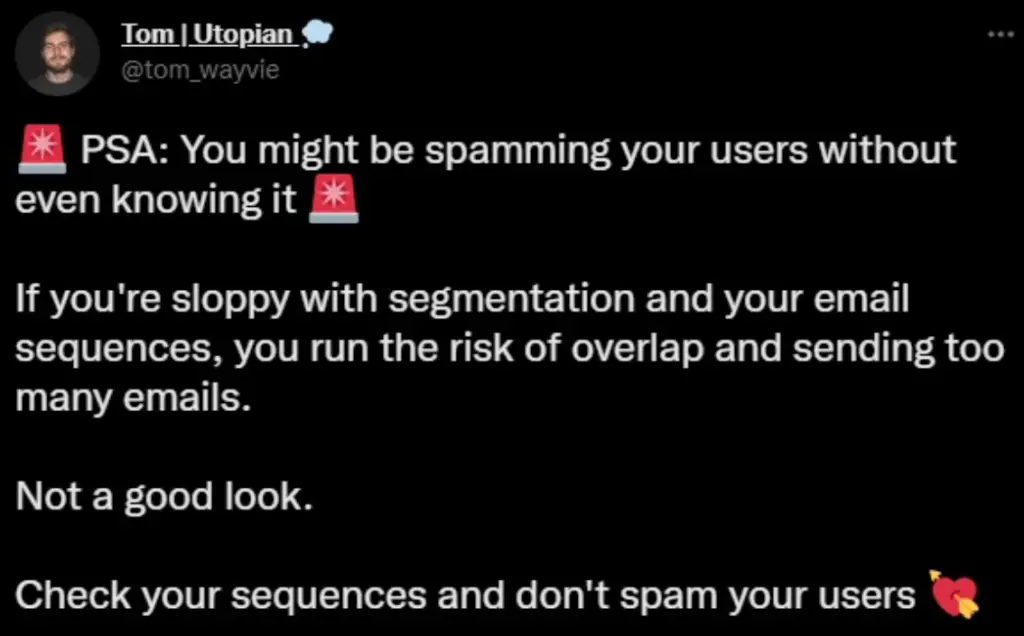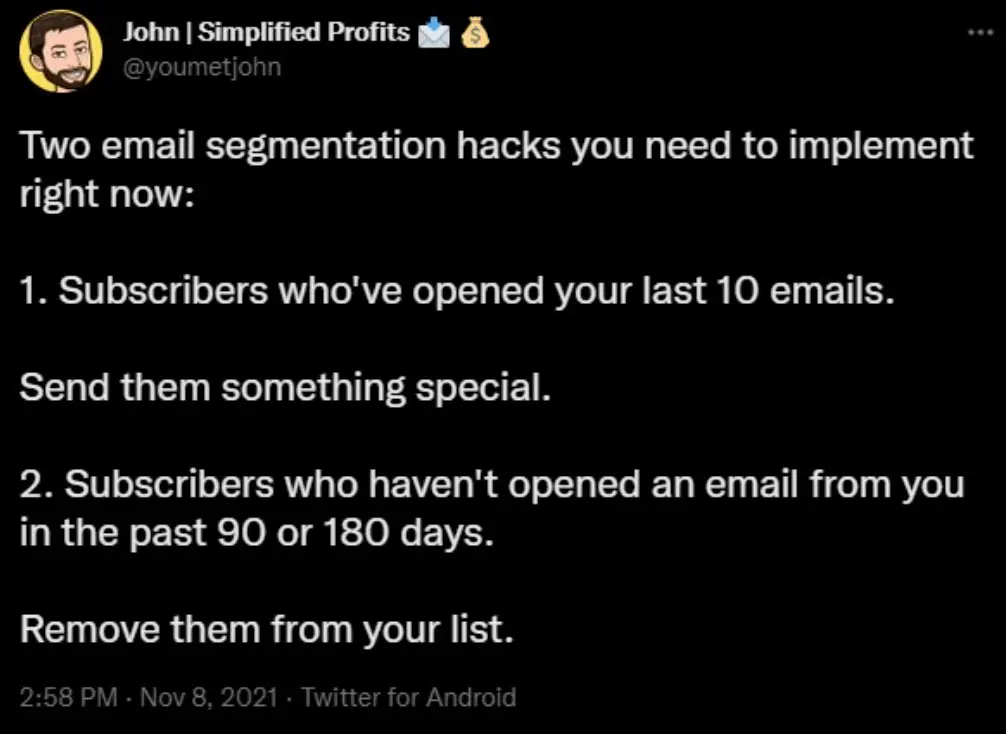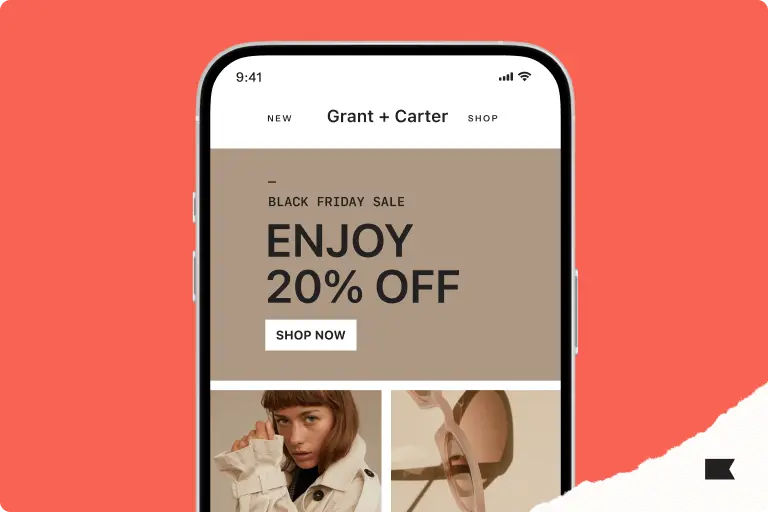Email segmentation guide: how to personalise your marketing messages and improve email ROI
Every brand reaches the point where they need to segment their email list to increase engagement and continue to hit—or, ideally, surpass—their email marketing and SMS marketing goals.
For some brands, it happens when they expand their product line and need to market different products to different segments.
For others, a rise in bounce back emails, spam complaints or low email click rates is what turns the team’s attention to email segmentation.
For others still, the turning point comes when they hire their first email marketing expert whose first recommendation is baseline segmentation—and suddenly, the team sees their email revenue skyrocket.
No matter what lands you here, congratulations! Email segmentation is often one of the early email marketing optimisations growing brands make to see more returns from their email and SMS lists.
In a nutshell, email segmentation divides your subscriber email lists into smaller portions based on customer interests and behaviour (personals). Segmentation helps you personalise your emails as a result of those smaller lists, so you always pique your customers’ interest and create customer experiences (emails and SMS messages) relevant to where your customer is in their relationship with your brand. It also increases the senders reputation and email deliverability metrics.
That personalised message is crucial in email marketing—for the customer experience, yes, but also to just stand out in general. Your customer’s inbox, after all, is a very competitive place.
More than 82% of marketers rely on email marketing, according to Statista. And the average open rate for all those emails is around 31%.
To cut through this cacophony of email and SMS messages (which are also on the rise), growing brands are focused on creating unique, personal digital experiences for their customers—beginning with how they talk to them.
To cut through this cacophony of email and SMS messages (which are also on the rise), growing brands are focused on creating unique, personal digital experiences for their customers—beginning with how they talk to them.
And for most brands, email segmentation is the starting line.
In this guide, we’ll delve deeper into what email segmentation is and how Klaviyo can help you create highly personalised marketing emails.
What is email segmentation?
Email segmentation is when you divide your master list of email subscribers into smaller groups, or “segments.” It’s a practice that empowers you to create highly personalised marketing campaigns or marketing automations to improve brand affinity, customer lifetime value (CLV), and brand reputation.
You can divide your email list based on factors like:
- Demographics: age, gender, income
- Behaviour: purchase history and browsing patterns
- Psychographics: interests, values, beliefs
Segmented campaigns take a bit more effort than the traditional batch-and-blast approach, but they help you overcome the common pitfalls of email marketing.
Batch and blast vs. segmented email marketing
It’s easy to maintain a single master email list and send the same email to all your customers. But this email marketing strategy, known as batch and blast, might do your business more harm than good in the long run.
That’s because batch and blast email marketing can easily:
- Hurt your email deliverability, especially as your list gets large
- Increase list attrition, which is the number of folks unsubscribing regularly
- Damage brand perception (folks think you’re annoying because you’re sending them irrelevant emails)
- Lower conversion overall, specifically impacting your ability to turn subscribers into customers or repeat customers (which affects the efficacy of your paid media campaigns, too)
Businesses often spend significant resources on designing email campaigns and automations but don’t give enough importance to the segmentation of the email lists for those campaigns and automations. In other words, they don’t think through the holistic subscriber experience.
I am always shocked when an ecommerce brand develops an email marketing strategy without utilising list segmentation.
Ashley Ismailovski, CRO operations manager, SmartSites
“I am always shocked when an ecommerce brand develops an email marketing strategy without list segmentation,” says Ashley Ismailovski, CRO operations manager, SmartSites. “The batch-and-blast approach to email marketing is a thing of the past. We no longer see value in emailing every subscriber in the database the same content. What consumers want now are personalised messages that keep them engaged with their favourite brands and allow them to receive only the most relevant content to them.”
Unlike batch and blast, an email service that offers advanced email list segmentation enables you to create highly personalised email marketing campaigns and email automations.
The “why” behind segmentation in email marketing
Email list segmentation is crucial for sending the right type of emails to the right people. But it’s also important because most countries now enforce data privacy laws.
Here are a few other reasons to use email list segmentation:
Every customer is unique
Your customers are unique in many ways. They may be based in different locations and have different ages, interests, and social backgrounds—which means one marketing size doesn’t fit all.
For example, if you run an apparel business, you may need to send personalised email content to account for different genders, not just one.
The unique behaviours and attributes of your subscribers and customers are what comprises Customer-First DataTM—the combination of zero- and first-party data.
First-party data refers to data you observe on your owned channels, such as what someone does on your website, what they buy, and when they open emails. Zero-party data is data customers hand over freely, such as when someone answers questions on an onsite quiz about their skin concerns or hair type.
Both of these types of data are highly valuable in email segmentation and can help you craft messages that match the needs and preferences of each individual customer.
Customer interests and motivations vary
Your customers’ interests and motivations also vary based on where they are in their lifecycle journey. For example, they may be just getting to know your products, or they may have made many purchases in the past.
Usually, you don’t want to send the same emails to a frequent buyer as you do to a new customer. Email segmentation based on someone’s location within the customer journey will ensure you’re always sending relevant emails.

Data privacy puts limits on social media marketing
Apple and Google’s recent privacy updates have created limitations for targeted marketing through social media.
Apple’s App Tracking Transparency (ATT) enables users to prevent businesses from tracking their online activity, curbing the effectiveness of targeted marketing on social media. Google, meanwhile, announced similar privacy updates that severely limit social media marketing.
One way to adapt to this privacy-first world is email segmentation and personalised email marketing.
Spamming has serious consequences
Due to strict data privacy laws, you need to be extremely careful about your emails. For example, you can’t use customer data from third-party lists, then batch and blast.
Spamming also affects email deliverability. When you send a generic marketing email, your customers might mark it as spam, lowering your sender reputation.
Spamming your customers is a major faux pas. Segmentation can help you stay away from it.

Your marketing resources can be used more effectively
Not all of your customers will react to your email marketing campaigns. Instead of wasting effort on a generic group, email segmentation uses your resources more efficiently by:
- Sending highly personalised emails to your most engaged customers
- Focusing on subscribers with high CLV

Longer-term customer relationships build a healthier business
Email segmentation helps you create emails that appeal to your customers personally. A relevant, highly personalised email shows your customers that you care about their interests and needs.
If you consistently send relevant emails, your customers are more likely to trust your brand.
Better customer understanding creates better marketing programs.
The process of digging into customer data for segmentation can give you deeper insights into their interests and behaviours.
Ultimately, that leads to a better understanding of your customers and how they engage with your brand—which can help you improve products and solutions in the long run.
The data-driven benefits of email list segmentation
We’ve seen how important email segmentation is for email marketing. Here are a couple of metric-oriented benefits to segmenting your email list:
Increase ROI for email marketing
Because segmenting your email lists helps you create highly personalised email messages for each customer group, and because customers are more interested in emails that match their interests, segmentation often results in higher open and click rates, more conversions, and greater revenue.
Paw.com, for example, achieved a 145x monthly average ROI using email segmentation in Klaviyo.
Klaviyo helps us not only engage better with our community, but also introduce new products in a way that’s more personal and relevant, less hitting them over the head with sales-speak.
Jeff Sass, CMO, Paw.com
“Klaviyo plays a critical role in re-engaging customers and bringing people back into the fold so they can expand what they can do with Paw.com,” says Jeff Sass, CMO, Paw.com. “We’re focused on supporting all aspects of the pet family lifestyle. Klaviyo helps us not only engage better with our community, but also introduce new products in a way that’s more personal and relevant, less hitting them over the head with sales-speak.”
Improve sender reputation and deliverability
When you segment email lists, your emails are directed at the right audience, making it more likely that your customers will find your emails highly relevant. That’s why email segmentation helps you achieve:
- Fewer spam complaints
- Higher open and click rates
- Lower unsubscribe rates
Remember, email service providers take all of the above into account while calculating your email deliverability score.
To maintain high email deliverability, I suggest implementing advanced segmentation.
Toccara Karizma, CEO, Karizma Marketing
“To maintain high email deliverability, I suggest implementing advanced segmentation,” says Toccara Karizma, CEO, Karizma Marketing. “It is a common practice to send email campaigns to a 90-day engaged audience, which can encompass behaviours such as active on site, viewed product, clicked email, and new subscribers.”
How to set up an email segmentation strategy
Segmenting your email lists isn’t difficult if you approach it systematically and rely on the tools provided by your email service. For example, Klaviyo helps you automate your email list management so that segmentation doesn’t overburden your team.
Here’s a step-by-step process to get started with email segmentation:
1) Determine your criteria for segments
Start segmenting from your subscriber master list.
First, think about the criteria you want to use for email segmentation. If your business is global, you may want to segment your subscribers based on geographic location.
Dividing your email list based on subscriber location is easy. But some other categories may not be so simple to define. For example, carefully consider how you would define a highly engaged customer.
Paw.com attributes 30% of its YOY growth to emails, assisted by Klaviyo’s email segmentation tools.
DTC pet brand and Klaviyo customer Paw segments their email list based on factors like pet breed, age, size, and even quirks like anxiety during fireworks. The brand attributes 30% of its YOY growth to emails, assisted by Klaviyo’s email segmentation tools.
“In Klaviyo, there are so many ways to segment our subscribers and then tailor these messages for them,” says Gina Finn, email marketing manager, at Paw.com. “The opportunities are kind of endless, which is really exciting. At the end of the day, we want to treat our customers’ pets like they’re our pets and part of our family.”
2) Collect customer data
You’ve defined your segments and criteria. But you need customer data to categorise subscribers into segments. It’s always better to collect data directly from your customers.
You can do that by collecting Customer-First DataTM.
Collect zero-party data from the first interaction. Then, use this to personalise the welcome series and feed into your campaign segmentation and retargeting strategy.
Adam Kitchen, CEO, Magnet Monster
“Collect zero-party data from the first interaction. Then, use this to personalise the welcome series and feed into your campaign segmentation and retargeting strategy,” suggests Adam Kitchen, CEO, Magnet Monster.
You can do the same thing with the other piece of Customer-First Data: first-party data, which usually means behavioural data like browsing patterns, products clicked, or cart abandonment.
3) Set up email segments
Once you’ve got your segment criteria and customer data ready, you can start segmenting your email lists.
Manually creating and maintaining lists may not be feasible if you have thousands of subscribers. So, make sure to choose one of the best email marketing platforms that offers tools for email segmentation automation.
Klaviyo’s robust segmentation features empower you to create email lists and update segments dynamically. You can also define different email flows for each segment and further personalise them through dynamic content blocks.
4) Monitor and adjust
You’re not done once you start sending emails to your segmented lists. Continuously monitor how your lists are doing by tracking email performance indicators like:
- Email open rate
- Click rate
- Spam complaint rate
- Conversion rate
Keep an eye on which email segments are doing well and which aren’t. Consider A/B testing your list criteria to optimise email performance.
Don’t have time to do this all yourself? Hire an email marketing expert!
3 email list segmentation ideas
There are different levels of email list segmentation. On the surface, you can segment your email lists based on customer age or gender. On a deeper level, you can segment your customers based on their personalities and values:
- Demographic email segmentation
- Behavioural email segmentation
- Psychographic email segmentation
Let’s go over each of these categories in detail.
1) Demographic email segmentation
Demographic segmentation is one of the easiest segmentations. Segment your email lists based on a person’s physical and situational characteristics such as location, age, and gender.
Email list segmentation based on geography
If you have a global audience, the simplest segmentation criteria is based on customer location. Geography can play a major role in determining people’s behaviour and interests. When you have a location-based email segment, you can:
- Send emails when the recipient is most active
- Send seasonal product emails
- Design emails around local events and festivals
- Tailor emails according to regional trends and buying patterns
For example, email segmentation based on geography prevents you from sending winter clothing emails to people who are currently enjoying summer.
Take a look at Asher Golf’s winter jacket email below for an example of geography-based personalisation done well.

Email list segmentation based on characteristics
Another crucial segmentation condition is demographics. People’s interests often vary based on demographic factors like age or gender.
If you run a lifestyle brand, for example, you can give your customers the option to choose whether they want to see men’s, women’s, both, or gender-neutral products.
Or, if your brand has age-specific products, then you’ll likely want to segment your email lists based on that. After all, product suggestions for a teenager may not be relevant for a middle-aged customer.
2) Behavioural email segmentation
Going a step further, you can segment your email lists based on customer behaviour. That could mean segmenting based on their buying patterns or interactions with your website.
Here are some examples:
Email segmentation based on past purchases
Your customers’ past purchase behaviour includes what they bought, how much they spent, and how often they spend money with you. This type of data makes excellent segmentation criteria.
Try dividing your email subscribers into different groups based on their purchase amount and frequency. Segments might include:
Newcomers to your business
Your master list may contain many subscribers who signed up to learn more about your brand or product, but who haven’t made their first purchase yet. Personalise your email marketing to them by:
- Affirming their decision to subscribe
- Showing them how your brand stands out
- Sharing your brand’s story and top products
- Including social proof like testimonials and customer reviews
Customers who have made at least one purchase
This group of customers already knows your brand. They might have subscribed to your email list to get a promotional discount or notifications about their favourite products.
If they signed up from a promotional offer page, they may be interested in discounts. But if they specifically signed up for a newsletter, they may be more interested in educational or brand content.
Try segmenting this group based on their motivation.
Highly active customers
Make a special email list segment for your most active customers. These are people who are invested in your brand and have made multiple purchases.
Creating a separate list for your loyal customers helps keep them engaged, especially if you offer perks like exclusive sales, free shipping offers, and early access to new products.
Through proper engagement emails, you can nurture these customers and turn them into loyal brand advocates.
Email segmentation based on customers’ online behaviour
Another method of behavioural segmentation is based on how customers interact with your brand. Here are a few examples of segmentation based on online behaviour:
Website activity
If you use a tool like Klaviyo for web tracking, you can segment based on customers’ activity on your website. Try creating multiple segments, such as:
- Customers who have spent a specific amount of time on your website
- Customers who looked through product pages but didn’t add anything to their cart
- Customers who abandoned their shopping carts
For example, “if a customer abandons a cart because they’re concerned about shipping times, a standard abandoned cart email with a discount on cart items isn’t likely to convince them to return to complete their purchase,” says Morgan Maguire, senior email marketing manager, The Stable. “Using Klaviyo’s segmentation capabilities and dynamic content blocks, you can create an effective abandoned cart flow that’s more personalised for different groups of customers.”
Using Klaviyo’s segmentation capabilities and dynamic content blocks, you can create an effective abandoned cart flow that’s more personalised for different groups of customers.
Morgan Maguire, senior email marketing manager, The Stable
You can also try personalising emails based on cart abandonment value. For those who abandon low-value carts, you might send a simple reminder email. But for higher cart values, you might want to sweeten the deal with an incentive, such as a discount code or free shipping.

Email engagement
You can also segment your lists based on email engagement levels.
For example, you can create 30-day engaged, 60-day engaged, and never engaged lists based on how often a recipient opens your emails. That way, you can focus on your most engaged customers.
Customer reviews
People who have left positive reviews may appreciate emails with positive messages. But those who have left negative reviews may want to see apologetic messages.
According to Accenture, 45% of customers felt that the coolest personalisation tactic is sending an apology email as a follow-up after they’ve had a bad experience.
Email segmentation based on CLV
Along with purchase history, you can segment your email list based on how much revenue a customer generates throughout their association with your brand—known as CLV.
With Klaviyo, you can make these lists based on both the revenue the customer has generated so far (known CLV) or future revenue estimate (predictive CLV).
Try segmenting your customers into the following categories based on CLV:
- VIP (all-time high CLV)
- Frequent purchasers
- Big spenders
- Unengaged VIPs
You may want to target high spenders and send them marketing emails with:
- Early access to new products
- Early access to sales
- Deeper discounts on sales
- Exclusive product drops just for them
3) Psychographic email segmentation
On the deepest level, you can create segments based on people’s values and beliefs. Start by collecting data on customers’ interests through surveys, quizzes, and questionnaires. This Customer-First Data will help you send targeted emails that appeal to your customers’ emotions.
Ask your customers questions like:
- How often do you go out?
- Do you like to wear light or glam makeup?
- Have you worn lashes before?
You can create different email segments based on customers’ responses to questions like these.
Customers can get more granular based on the answers they provide on your quiz. Based on all those answers, brands can enter customers into a different flow.
With psychographic segmentation, it doesn’t feel like you’re getting another email. It feels like you’re being communicated to.
Email list segmentation best practices
Now that you know how to create email lists and segment your master email list, let’s take a look at 4 email list segmentation best practices.
1) Keep your segments simple
As we’ve seen, email list segmentation is a highly beneficial marketing technique. But you don’t want to overdo it.
For example, if you’re starting with a small subscriber list, you don’t want to create tiny email segments with few recipients. When creating segments, you need to pick out criteria that will actually make a difference.
To decide which criteria offers the best results, we recommend two methods:
- A/B test your marketing emails with different segmentation criteria.
- Use customer-first marketing to learn what matters to your customers.
2) Collect preferences directly from your customers
There’s no better way to get information from your customers than to simply ask for it.
Ask about their favourite products or how often they want to receive emails. And let your customers select their preferred channel of communication—email, SMS, or both.
Include messaging preferences in every marketing email or SMS so subscribers can opt in or out from specific email lists or SMS flows.
Hollow, for example, sends this very clear message to collect customer email preferences:

3) Keep updating your email list segments
A subscriber can move from one segment to another quite quickly based on many factors, such as:
- An action they performed, like opening an email, purchasing, or abandoning a cart
- Changing demographics or location
Keeping track of those events and manually updating your email list can be a lot of work. You can do that on Klaviyo if manual is more your speed, but Klaviyo also supports automatic list segment updates based on a variety of criteria.
4) Monitor your email marketing performance
Your email marketing campaign isn’t complete until you measure its performance. Monitor your segmented lists’ key performance indicators (KPIs) on an ongoing basis.
Here are a few important email marketing KPIs to keep an eye on:
- Open rate
- Click rate
- Conversion rate
- Revenue per recipient
Don’t hesitate to adjust your segments or get rid of any that don’t make a difference to your email marketing ROI.
Note: As of September 2021, iOS users can turn off open tracking. You may want to exclude iOS users while looking at open rates.
Email segmentation tools
Segmenting your email lists and designing different email workflows is a complex task that’s tough to handle manually.
Also, your segmented email list should change dynamically, based on customer behaviour and their position in the sales lifecycle.
The good news? Klaviyo offers extensive email list segmentation tools for both beginners and advanced audiences.
With Klaviyo, you can create dynamic email lists based on all the criteria we’ve discussed so far. Once you’ve defined your email list segments, you can design email flows to be triggered when someone is added to a segment.
Make your emails truly personalised using Klaviyo’s dynamic content blocks feature. You can also create email segments based on predictive analysis.
Klaviyo empowers you to go beyond basic email segmentation strategies. The platform enables you to join multiple conditions and create niche segments, such as:
- Cross-sell
- Item or brand-specific
- Churn-risk
- Average order value
- Holiday shoppers
Final thoughts: email marketing segmentation—a concrete way to improve email marketing
With high competition in email marketing, the traditional batch-and-blast approach won’t yield results. But highly personalised email marketing campaigns can improve your conversions, brand image, and email deliverability.
Segmenting your email lists is crucial for providing subscribers a unique, personal experience. You can segment your email list based on a variety of different factors, such as:
- Demographic data
- Behavioural data
- Psychographic data
While email list segmentation helps you achieve better results, it’s vital to follow segmentation best practices, like:
- Keeping segments simple
- Collecting Customer-First Data for better engagement
- Updating your email list segments regularly
- Monitoring your email marketing performance
You’ll need a feature-rich email service provider like Klaviyo to automate your email segmentation tasks. Klaviyo helps you create niche segments based on predictive analysis and advanced criteria.

Related content

Migrating to Klaviyo? Get expert insights on timing, tools, and tips to maximize your impact before Black Friday & Cyber Monday.

Explore Black Friday Cyber Monday email examples from top brands like Beyond Yoga and Twinings. Learn what worked, get expert tips, and see their successful results.

Learn more about the best time to send marketing emails. Pinpoint the optimal time to capture user attention to boost engagement and ROI.